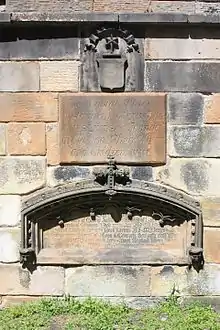George Jardine
Rev Prof George Jardine FRSE (1742–January 28, 1827) was a Scottish minister of religion, philosopher, academic and educator. He was Professor at the University of Glasgow, of Greek from 1774, and then Professor of Logic and Rhetoric 1787 to 1824.[1] He was a co-founder of the Royal Society of Edinburgh in 1783 and co-founder of Glasgow Royal Infirmary in 1792.
- For the Australian rugby league footballer, see George Jardine (rugby league).
At the University of Glasgow he was a pioneer of collaborative learning;[2] he wrote up his method in a book.[3] He designed a peer review method with rules to be followed by peer editors, whom he labeled “examinators.” By participating in collaborative learning settings, Jardine thought, students develop interpersonal traits and skills “indispensable at once to the cultivation of science, and to the business of active life.”[4]
Life

He was born in 1742 at Wandel in Lanarkshire where his predecessors had resided for nearly two hundred years.[5] His mother was a daughter of Weir of Birkwood, in the parish of Lesmahagow. Jardine was transferred in October 1760 from the parish school to Glasgow College, and after passing through the arts and divinity courses (MA 1765), was licensed to preach by the presbytery of Linlithgow.
In 1770 he went to Paris as tutor to the sons of William Mure of Caldwell, who obtained for him from David Hume introductions to Helvetius and D'Alembert. Soon after his return from France in July 1773, he failed to secure election to the chair of humanity at Glasgow, by a single vote, but in June 1774 was appointed professor of Greek and assistant professor in logic. In 1787 he became sole professor of logic.
Jardine gave a practical turn to the teaching of his chair, and established a system of daily examination. His classes rose from an average of fifty to nearly two hundred. He expounded his principles of teaching in his Outlines of Philosophical Education, published at Glasgow, 1818; 2nd edit. 1825. He was also an administrator and brought the finances of the college to order.
Jardine created the introductory college course, which presented new or difficult material in small and digestible pieces rather than as a single imposing system that students had to either understand or fail. Jardine also insisted that lectures be interspersed with regular examinations, in order to gauge the students’ progress, and on which students had to write themes or original essays. His Outlines of Philosophical Education, Illustrated by the Method of Teaching the Logic Class at the University of Glasgow became one of the most popular textbooks in American higher education. It explained how to create a stimulating intellectual atmosphere in the classroom and lecture hall. It created a system of “writing across the curriculum,” as it would later be called, with compositions, essays, and research papers assigned in every class and at every level, which taught students how to think for themselves, but also how to write clear, incisive, original English prose.[6]
He had a country house, Hallside (near Cambuslang and modern-day Drumsagard Village) constructed in 1790.[7]
He was one of the founders in 1792, and afterwards for more than twenty years secretary, of Glasgow Royal Infirmary. For over thirty years he was the representative of the presbytery of Hamilton in the General Assembly of the Church of Scotland. He retired from the chair of logic in 1824, and died on 27 January 1827.
He is buried in the Lindsay plot on the north side of the churchyard around Glasgow Cathedral.
Family
In 1776 Jardine married Janet Lindsay, daughter of John Lindsay, founder in Glasgow. She died in 1815. They had one son, John Jardine, advocate, who held the office of sheriff of Ross and Cromarty, and died in 1850.
They are both buried with him.
Legacy
Among those apparently influenced by Jardine was Alexander Campbell, founder of Bethany College, West Virginia.[8][9] Jardine's pupils included Christopher North[10] and Sir William Hamilton.[11]
Artistic Recognition
Jardine's portrait, by John Graham-Gilbert, hangs in the Hunterian Art Gallery in Glasgow.[12] He was also painted by Thomas Hodgetts in 1827.[13]
Notes
- Comments on teaching style .
- Lynée Lewis Gaillet, A Foreshadowing of Modern Theories and Practices of Collaborative Learning: The Work of Scottish Rhetorician George Jardine. (1992)(PDF). See also the same author's A Genesis of Writing Program Administration: George Jardine at the University of Glasgow in Historical Studies of Writing Program Administration: Individuals, Communities, and the Formation of a Discipline (2004) editors Barbara L'Eplattenier and Lisa Mastrangelo, ISBN 1-932559-22-1, ISBN 1-932559-23-X, ISBN 1-932559-24-8.
- Outlines of Philosophical Education, illustrated by the Method of Teaching the Logic Class in the University of Glasgow; see for example "Archived copy". Archived from the original on 27 September 2007. Retrieved 14 June 2007.CS1 maint: archived copy as title (link), .
- Social Presence: The Secret Behind Online Collaboration, by Mary Beth Lakin Archived 10 August 2007 at the Wayback Machine.
- Chambers, Robert (1874–1875). A biographical dictionary of eminent Scotsmen. Blackie & Son. p. 387. Retrieved 12 July 2016.
- Herman, How Scots Invented the Modern World (Three Rivers Press, 2001, p. 391
- Country Houses of the old Glasgow gentry – Hallside House
- "American Moral Philosophy In The Nineteenth Century". Archived from the original on 4 June 2002. Retrieved 14 June 2007.CS1 maint: bot: original URL status unknown (link)
- For Jardine's general influence, see Arthur Herman, The Scottish Enlightenment: The Scots' Invention of the Modern World (2002), p. 372.
- Romanticism On the Net 20 (November 2000)
- Scottish Philosophy in the 19th Century (Stanford Encyclopedia of Philosophy)
- http://artuk.org/discover/artworks/professor-george-jardine-17421827-170534
- https://art.nationalgalleries.org/search/artist/thomas-hodgetts
References
 This article incorporates text from a publication now in the public domain: "Jardine, George". Dictionary of National Biography. London: Smith, Elder & Co. 1885–1900.
This article incorporates text from a publication now in the public domain: "Jardine, George". Dictionary of National Biography. London: Smith, Elder & Co. 1885–1900.